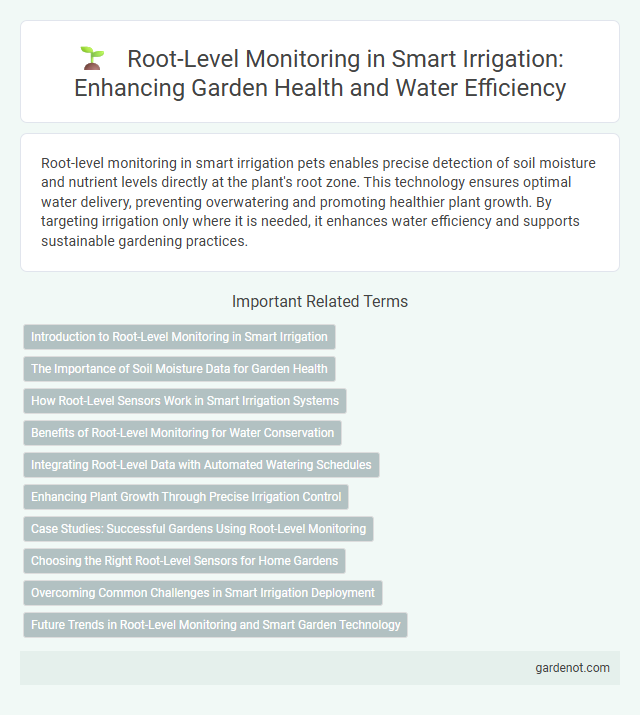Root-level monitoring in smart irrigation pets enables precise detection of soil moisture and nutrient levels directly at the plant's root zone. This technology ensures optimal water delivery, preventing overwatering and promoting healthier plant growth. By targeting irrigation only where it is needed, it enhances water efficiency and supports sustainable gardening practices.
Introduction to Root-Level Monitoring in Smart Irrigation
Root-level monitoring in smart irrigation involves using sensors to measure soil moisture, temperature, and nutrient levels directly at the root zone, ensuring precise water delivery based on real-time data. This approach optimizes water usage by preventing over-irrigation and promoting healthy plant growth through targeted hydration. Advanced root-level monitoring systems integrate with automated irrigation controls to enhance crop yield and conserve resources.
The Importance of Soil Moisture Data for Garden Health
Soil moisture data is crucial for smart irrigation systems to optimize water usage by accurately measuring water availability at the root level. Effective root-level monitoring ensures plants receive sufficient hydration without overwatering, promoting healthy root development and preventing diseases caused by excess moisture. Integrating soil moisture sensors into irrigation management enhances garden health, improves water efficiency, and supports sustainable gardening practices.
How Root-Level Sensors Work in Smart Irrigation Systems
Root-level sensors in smart irrigation systems detect soil moisture and nutrient levels by measuring electrical conductivity and dielectric constant within the root zone. These sensors transmit real-time data to an irrigation controller, enabling precise water application based on actual plant needs, reducing water waste, and promoting optimal crop growth. Integration with weather and soil data enhances the system's efficiency, allowing adaptive irrigation schedules tailored to specific root-zone conditions.
Benefits of Root-Level Monitoring for Water Conservation
Root-level monitoring in smart irrigation systems enables precise measurement of soil moisture and nutrient levels directly at the plant's root zone, optimizing water usage and reducing waste. This targeted approach prevents overwatering and ensures plants receive the exact amount of water needed for healthy growth, significantly conserving water resources. Studies show that root-level monitoring can improve irrigation efficiency by up to 30%, promoting sustainable landscaping and agricultural practices.
Integrating Root-Level Data with Automated Watering Schedules
Root-level monitoring enhances smart irrigation by providing precise soil moisture and nutrient data directly from the plant's root zone, enabling more efficient water usage. Integrating this data with automated watering schedules allows irrigation systems to deliver water based on real-time soil conditions, reducing overwatering and water waste. This targeted approach optimizes plant health, promotes sustainable water management, and supports advanced precision agriculture technologies.
Enhancing Plant Growth Through Precise Irrigation Control
Root-level monitoring utilizes advanced sensors to measure soil moisture and nutrient levels directly at the plant's root zone, enabling precise irrigation control. This technology optimizes water use by delivering the exact amount needed, reducing wastage and promoting healthier plant development. Enhanced data accuracy supports improved growth rates, increased crop yields, and sustainable agricultural practices.
Case Studies: Successful Gardens Using Root-Level Monitoring
Root-level monitoring enhances water efficiency by providing precise soil moisture data, enabling tailored irrigation schedules that improve plant health and reduce water waste. Case studies from gardens in California and Israel demonstrate significant water savings of up to 40% while increasing crop yields by 15%. These examples highlight the effectiveness of integrating sensor technology in sustaining healthy root zones and optimizing overall irrigation management.
Choosing the Right Root-Level Sensors for Home Gardens
Selecting the right root-level sensors for home gardens enhances smart irrigation efficiency by accurately measuring soil moisture, temperature, and nutrient levels. Capacitive and resistive sensors offer reliable real-time data while maintaining affordability and ease of installation. Integrating sensors compatible with IoT platforms ensures precise water delivery, promoting healthy root development and conserving water resources in residential settings.
Overcoming Common Challenges in Smart Irrigation Deployment
Root-level monitoring in smart irrigation enhances water efficiency by delivering precise moisture and nutrient data directly from the soil. Overcoming challenges such as sensor calibration errors and data integration issues requires advanced algorithms and IoT connectivity. Implementing robust wireless sensor networks ensures continuous, accurate monitoring to optimize irrigation schedules and improve crop yield.
Future Trends in Root-Level Monitoring and Smart Garden Technology
Future trends in root-level monitoring emphasize the integration of advanced sensors and AI-driven analytics to optimize water usage in smart irrigation systems. Emerging technologies enable real-time soil moisture and nutrient detection at the root zone, enhancing precision agriculture and reducing water waste. Smart garden technology will increasingly incorporate IoT connectivity to provide seamless data-driven insights, promoting sustainable plant growth and resource management.
Root-level monitoring Infographic

 gardenot.com
gardenot.com